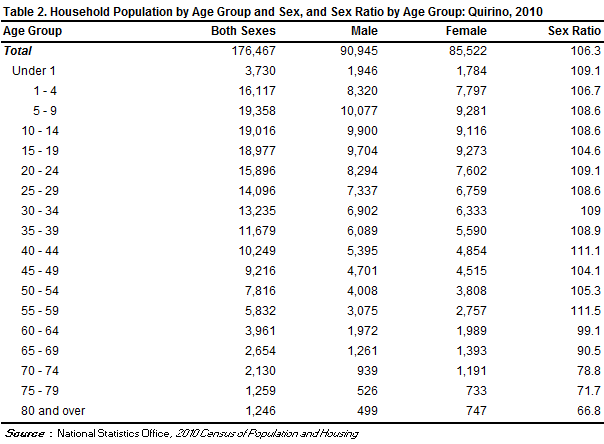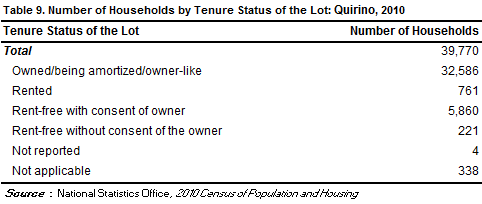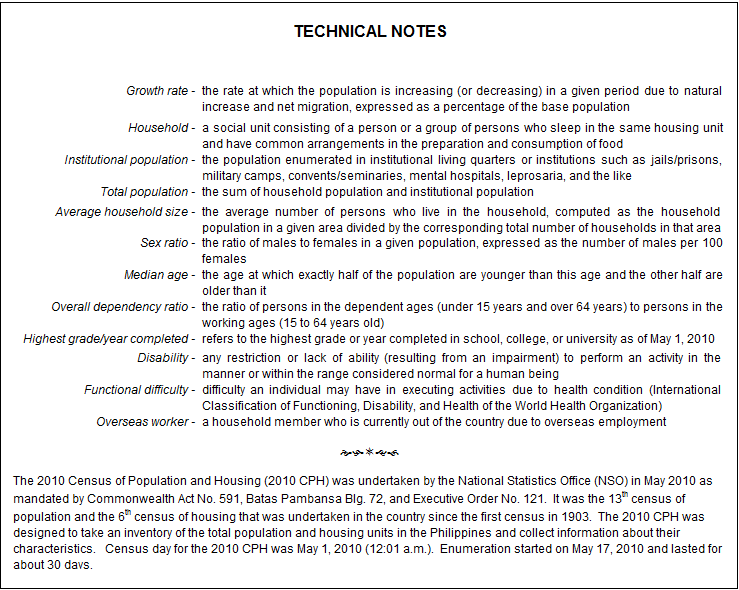Population of Quirino increased at the rate of 1.75 percent annually
Based on the 2010 Census of Population and Housing (CPH), the province of Quirino posted a total population of 176,786 persons as of May 1, 2010, larger by 28,211 persons compared to its total population of 148,575 persons counted in the 2000 CPH. The increase in the population count from 2000 to 2010 translated to an average annual population growth rate (PGR) of 1.75 percent, lower than the 2.67 percent annual PGR of the province between the census years 1990 and 2000.
If the average annual PGR recorded at 1.75 percent during the period 2000 to 2010 continues, the population of Quirino will double in 40 years.
Fifty years ago, the population of Quirino was only 24,266 persons. This population size is less than 15.0 percent of the population of the province in the 2010 CPH.
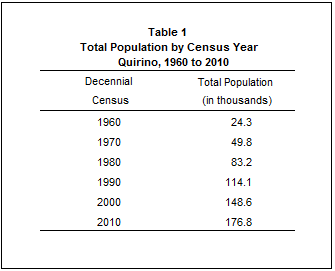
Diffun was the most populous municipality
Among the six municipalities comprising the province of Quirino, the municipality of Diffun was the most populous with a population size making up 27.4 percent of the total provincial population.
Diffun was followed by the municipalities of Maddela with 20.2 percent share, Cabarroguis, the provincial capital with 16.6 percent, Aglipay with 14.8 percent, Nagtipunan with 12.7 percent, and Saguday with 8.3 percent.
In 2000, the municipality of Saguday was also the least populated municipality.
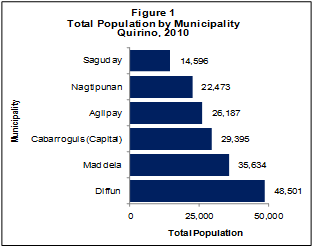
Sex ratio was 106 males per 100 females
Of the 176,467 household population in 2010, males accounted for 51.5 percent while females comprised 48.5 percent. These figures resulted in a sex ratio of 106 males for every 100 females. In 2000, the sex ratio was the same as that in 2010.
Median age increased to 23.5 years
In 2010, the median age of the population of the province was 23.5 years, which means that half of the population was younger than 23.5 years. This is higher than the median age of 20.7 years that was recorded in 2000.
Moreover, about one in every three persons (33.0 percent) was under 15 years old. Children aged 0 to 4 years comprised the largest share (11.2 percent), followed by those in the age groups 5 to 9 years (11.0 percent) and 10 to 14 years (10.8 percent). Males outnumbered females in the age groups 0 to 59 years. On the other hand, there were more females than males in the age groups 60 years and over.

Three fifths of the population were of voting age
The voting-age population (18 years and over) accounted for 60.5 percent of the population of the province in 2010, higher than that of 55.5 percent in 2000. There were more males (51.4 percent) than females (48.6 percent) among the voting-age population.
Dependency ratio decreased to 59 dependents per 100 persons in the working age group
In 2010, the young dependents (0 to 14 years) comprised 33.0 percent of the household population while the old dependents (65 years and over) posted a share of 4.1 percent. The working-age population (15 to 64 years) accounted for the remaining 62.9 percent.
The overall dependency ratio was 59, which indicates that for every 100 working-age population, there were about 59 dependents (52 young dependents and seven old dependents). This ratio is lower than the dependency ratio in 2000, which was recorded at 70 dependents per 100 working-age population (64 young dependents and six old dependents).
There were more males than females among the never-married persons
Of the household population 10 years old and over, 53.1 percent were married while 39.8 percent were never married. The rest of the populations were categorized as follows: widowed (4.3 percent), in common-law/live-in marital arrangement (1.8 percent), and divorced/separated (1.0 percent).
The males (56.7 percent) outnumbered the females (43.3 percent) among the never-married persons. For the rest of the categories for marital status, the females outnumbered the males.
More females had attained higher levels of education
Of the household population aged five years and over, 41.1 percent had attended or completed elementary education, 31.6 percent had reached or finished high school, 8.3 percent were college undergraduates, and 8.1 percent were academic degree holders. The females (59.2 percent) outnumbered the males (40.8 percent) among those with an academic degree. Likewise, there were more females (65.2 percent) than males (34.8 percent) among those with post baccalaureate courses.
Persons with disability comprised 1.8 percent of the population in the province
In 2010, around 3,200 persons or 1.8 percent of the 176,467 household population had a disability. This proportion of persons with disability (PWD) is higher than the proportion in 2000, which was 1.1 percent of the 148,515 household population of the province during that year. The number of PWD for the same year was around 1,600.
More males than females among those with functional difficulty
Of the 156,620 household population five years and over, 2.4 percent (or 3,821 persons) had at least one type of functional difficulty either in seeing, hearing, walking or climbing steps, remembering or concentrating, self-caring (bathing or dressing), or communicating. There were more males (50.2 percent) than females (49.8 percent) among those persons with at least one type of functional difficulty.
Moreover, of the total 3,821 persons aged five years and over with at least one type of functional difficulty, 55.0 percent reported difficulty in seeing, even if wearing eyeglasses. There were 34.9 percent who had difficulty in walking or climbing steps; 27.1 percent had difficulty in hearing, even if using a hearing aid; 18.8 percent had difficulty in remembering or concentrating; 16.9 percent had difficulty in communicating; and 12.4 percent had difficulty in self-caring (bathing or dressing).
Female overseas workers outnumbered their male counterparts
Of the 137,262 household population 10 years old and over in Quirino, 3.2 percent (or 4,413 persons) were overseas workers. Female overseas workers outnumbered their male counterparts as they comprised 73.6 percent of all the overseas workers of this province. Overseas workers aged 25 to 29 years made up the largest age group, comprising 22.7 percent of the total overseas workers from this province in 2010, followed by the age groups 30 to 34 years (22.1 percent), 35 to 39 years (17.4 percent), and 45 years and over (13.5 percent).
Average household size was 4.4 persons
The number of households in 2010 was recorded at 39,770, higher by 9,189 households compared with the 30,581 households posted in 2000. The average household size in 2010 was 4.4 persons, lower than the average household size of 4.9 persons in 2000.

There were 101 households per 100 occupied housing units
In 2010, a total of 39,388 occupied housing units were recorded in the province of Quirino. This translates to a ratio of 101 households for every 100 occupied housing units, with 4.5 persons per occupied housing unit. In 2000, there were 101 households per 100 occupied housing units, and 4.9 persons per occupied housing unit.
Occupied housing units with outer walls and roofs made of strong materials increased
In 2010, 42.0 percent of the housing units in Quirino province had outer walls made of concrete/brick/stone, up from 25.2 percent in 2000. The proportion of the occupied housing units with outer walls made of wood decreased from 34.0 percent in 2000 to 32.2 percent in 2010. Meanwhile, majority (88.7 percent) of the occupied housing units in 2010 had roofs made of galvanized iron/aluminum. This is higher than the proportion recorded in 2000 at 72.4 percent. Those with roofs made of cogon/nipa/anahaw decreased from 23.3 percent in 2000 to 8.8 percent in 2010.
Majority of the households lived in lots that they owned or amortized
In 2010, of the total 39,770 households, 81.9 percent owned or amortized the lots that they occupied. The corresponding figure in 2000 was 81.8 percent.
Moreover, 14.7 percent of the households occupied lots which were rent-free but with consent of the owner, 1.9 percent rented the lots that they occupied while 0.6 percent occupied lots which were rent-free but without consent of the owner.

